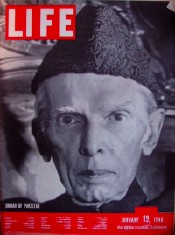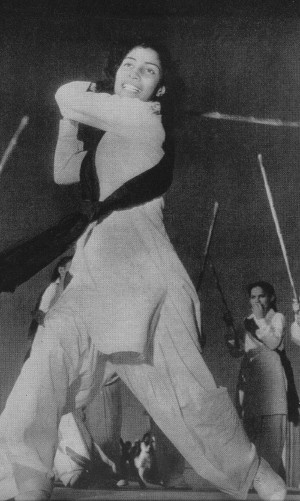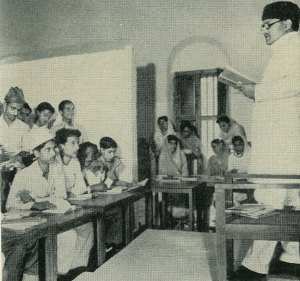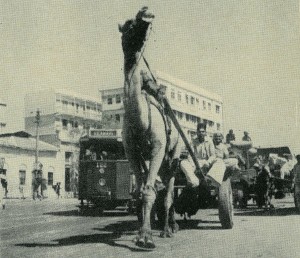Adil Najam
 A few years ago a friend gave me a wonderful gift. A copy of the January 4, 1948 issue of LIFE magazine. This is the issue with a rather unflattering portrait of a clearly ailing ‘Jinnah of Pakistan’ on its cover.
A few years ago a friend gave me a wonderful gift. A copy of the January 4, 1948 issue of LIFE magazine. This is the issue with a rather unflattering portrait of a clearly ailing ‘Jinnah of Pakistan’ on its cover.
For most part the cover story – with pictures by Margaret Bourke-White – is as unflattering as the picture of Mr. Jinnah on the cover. Margaret Bourke-White is an important chronicler of the events of 1947 and beyond in both India and Pakistan. She has strong views on these events, including on the creation of Pakistan and on Mohammad Ali Jinnah. These views, also reflected in the LIFE article, are much discussed and sometimes debated in academic and popular treatise. These are not the subject of this post.
What has always fascinated me much more, and what I want to talk about today, are the pictures and accounts of everyday life in Pakistan at its birth. How severe were the existential challenges of survival the country faced at that time. How much has changed. And how much has not.
 This being LIFE, the real story is in the pictures much more than in the text. My favorite picture is the one on the right. The caption reads:
This being LIFE, the real story is in the pictures much more than in the text. My favorite picture is the one on the right. The caption reads:
“MODERN PAKISTAN WOMEN are symptomatic of the progress the new nation is struggling to make. Here, led by Zeenat Haroon, young members of the Sind province Women’s National Guard meet to practice the use of the bamboo lathi in self-defense. But most Pakistan women still prefer the old custom, even to the veiled face.”
Personally, I am not a fan of laathi-wielding women; or men. However, the look of confidence on young Zeenat Haroon’s face is priceless; and the gist of the caption remains true today.
 Another interesting photograph shows how college co-education was managed. The caption reads:
Another interesting photograph shows how college co-education was managed. The caption reads:
MOSLEM COLLEGE in Karachi represents an effort to reduce Pakistan illiteracy rate of 97%. Girls in background are seated out of boys’ view to preserve their modesty.
Much of the article is in the context of the politics of the, then, emerging Kashmir conflict. The main thesis is, however, clear:
“Last week as the tragic division between Pakistan and India increased and as the 72-year old Jinnah grew sicker, it became apparent that Pakistan not only might lose its battle for survival but might also lose its leader.”
The author obviously believed that the country would not survive. One should, however, not be too harsh on her for that judgment. The analytical facts and the weight of ‘informed’ opinion were on her side and it was not an uncommon, nor unreasonable, opinion to hold at that time. For example, the analytical fulcrum of the write-up is a half-page section titled “Despite Lack of Money and Skills Nation Fights to Avoid Collapse.”
“When Pakistan suddenly received its freedom last Aug. 15, proud and energetic patriots boasted that they had created a nation with more land than France and more people than Germany. Granting these comparisons, Pakistan still lacks most of the attributes of a modern state.”
The section then goes on to indicate how Pakistan was “fighting a close battle with economic bankruptcy” in six key areas: Labor, Food, Raw Materials, Industry, Transportation and Finances. A few of these are reproduced here:
“Labor: Of the approximately 70 million Pakistanis more than 80% are farmers, a very few are wealthy landlords and the rest are shopkeepers and artisans. Nearly all of Pakistan’s financial and professional men were among the approximately four million Hindus who fled to India. From India, Pakistan got about siz million impoverished Moslem peasants who for the most part left their agricultural implements behind. Pakistan has huge transient camps fll of landless farmers and an almost complete lack of skilled technicians or businessmen.”
“Industry: …At present in all of Pakistan there are only 26,000 workers employed in industry. She has no big iron and steel centers, only 34 railway repair shops, no match factories, no jute mills, no paper mills and only 16 cotton mills against India’s 857…”
“Transportation: In all the 370,000 square miles of Pakistan there are only 7,260 miles of railway and only 9,575 miles of paved roads. There are an estimated 53,000 miles of dirt roads and trails… Pakistan has had difficulty in getting enough coal to keep the railways running and even then has had to pay about three times teh normal price per ton In September alone the country lost more than $10 million on railway operations.”
“Finances: Pakistan’s financial troubles are compounded out of her political, trade and industrial failures. At the time of the division Hindu businessmen took out all the gold bullion, jewels and other liquid assets they could carry with them. With normal trade cut off by the rioting and use of railroads for refugees, Pakistan’s income probably will not exceed 450 million rupees for the current year against almost certain expenditures of 800 million. Officials talk hopefully of foreign investment or loans, but in Pakistan’s present condition the risks are not very attractive.”
 Another picture in the cover-story depicts the realities that this analysis is pointing towards. The caption reads:
Another picture in the cover-story depicts the realities that this analysis is pointing towards. The caption reads:
“ONE CAMEL TOWN” would be a good description of Karachi in terms of world capitals. Although the city has some modern transport, communications are inadequate.”
By way of conclusion, let me just say that I have never believed that being dealt a bad hand at birth is any excuse for all the ways that we have messed up our political and economic affairs since then. Having said that, as I re-read the LIFE issue today, I could not help thinking that the country survived those early years despite all the odds was no mean achievement.
Ms. Margaret Bourke-White was probably not the only one surprised by this fact. Unfortunately, this makes thinking about all the mistakes we have made since then only that much more painful.
Note: Originally posted at ATP on 13 August, 2007.


















































This is amazing.
Specially when you read the description of the assets that we started with it is a miracle that we survived at all. What is sad is that we could not build on that early success.
We have made too many mistakes but it is still not too late to learn from them.
I live amongst a crowd of many Pakistani and Indian students. We do a lot of discussions amongst ourselves that are very candid. Last night we had a long heated debate (no hard feelings though :)) in our dorm room, I am just posting the points our Indian friends (both Hindu and Muslim) made yesterday as some may find them interesting:
1. It is much more easier to manage a small messy shop than a huge messy one. India managed a huge messy shop with relatively little to no resources per capita to start with and a huge minority population with sometimes conflicting interests to boot. How come it was able to do reasonably well (despite their rampant poverty)? What lesson can we Pakistanis take from it?
2. Indian Muslims always had to struggle, as mentioned by people in previous posts. Was this struggle good for them? How come they produced stalwarts like Shahrukh Khan(Biggest Muslim star ever), Asim Premji (Richest Muslim enterpreneur ever), APJ Abdul Kalam (One of the greatest Muslim leader/scientists ever) to name a few? Do majority Muslims living in India today regret staying in India? Do they envy Pakistani Muslims for our freedom? Are they desperate to pack their bags and come to Pakistan? No one can speak for 170 million Indian Muslims, but you may guess the answer.
3. India has preserved it’s diversity better than Pakistan. It sees problems everyday because diversity exists there. But they benefit from it tremendously, from a Sikh PM to Christian Kingmaker (Sonia) to Muslim President/Scientist leading a Hindu built infrastructure. Their troubles which come with their diversity are still nothing in front of the benefits they derive from it.
These are difficult questions, but we need to ask them. Also, most of us agreed that WE NEED TO STOP THINKING ABOUT THE PARTITION NOW. We need to move on, we are two different countries. Pakistan has the potential to do much better than India, specially because of it’s relatively small size, we have an easier problem to solve. Look at Japan, that is the model country for us to follow.
@Being a Karachiite,
my impression is identic to the one given by Omer,
not every appriciation by Bourk was intelligent, but pure
idiotic naivety, and even today its still more or less the same.
Karachi was cleaner than New York or London.
Very moving information!
And a respectable personal conclusion from u .
Hope and efforts have to survive and will inshaAllah prevail.
Lets pretend ,
our country has just emerged on the map of this world,
it has all the original obstacles and a handful more.
So lets start fresh and stop blaming others .
The middle class has to realize their power and put a leash on these politicians.
There is a village by the name ‘WALANA’ near Chakwal.
It has set an example of what we may call people power or resident power and burns a small flame of HOPE in our land.
Hey readers who care! Start doing all u can in ur own capacity and Stop complaining…….
pakistan zindabad.pakistan is our country we have right on our country.now i realized when i am not there.pakistan is the king of countries.in which there is hope,peace,unity etc.i love pakistan